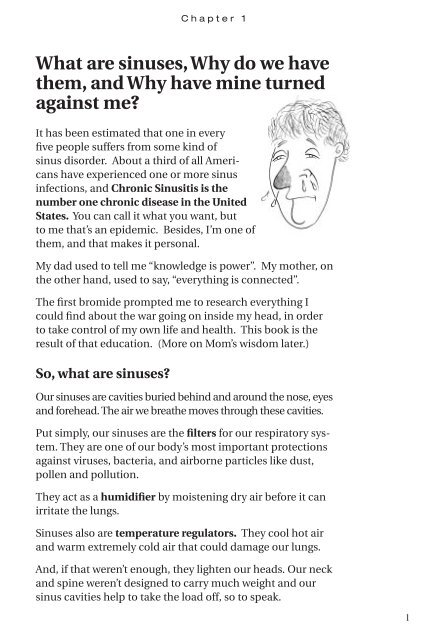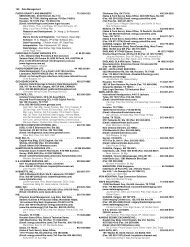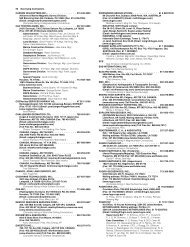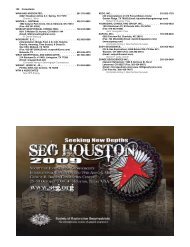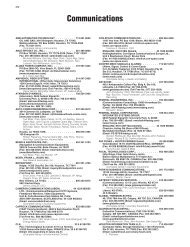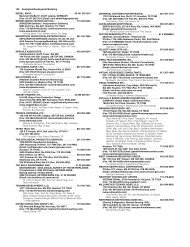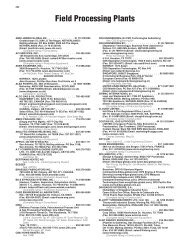Download Chapter 1 now
Download Chapter 1 now
Download Chapter 1 now
Create successful ePaper yourself
Turn your PDF publications into a flip-book with our unique Google optimized e-Paper software.
What are sinuses, Why do we have<br />
them, and Why have mine turned<br />
against me?<br />
It has been estimated that one in every<br />
five people suffers from some kind of<br />
sinus disorder. About a third of all Americans<br />
have experienced one or more sinus<br />
infections, and Chronic Sinusitis is the<br />
number one chronic disease in the United<br />
States. You can call it what you want, but<br />
to me that’s an epidemic. Besides, I’m one of<br />
them, and that makes it personal.<br />
My dad used to tell me “k<strong>now</strong>ledge is power”. My mother, on<br />
the other hand, used to say, “everything is connected”.<br />
The first bromide prompted me to research everything I<br />
could find about the war going on inside my head, in order<br />
to take control of my own life and health. This book is the<br />
result of that education. (More on Mom’s wisdom later.)<br />
So, what are sinuses?<br />
C h a p t e r 1<br />
Our sinuses are cavities buried behind and around the nose, eyes<br />
and forehead. The air we breathe moves through these cavities.<br />
Put simply, our sinuses are the filters for our respiratory system.<br />
They are one of our body’s most important protections<br />
against viruses, bacteria, and airborne particles like dust,<br />
pollen and pollution.<br />
They act as a humidifier by moistening dry air before it can<br />
irritate the lungs.<br />
Sinuses also are temperature regulators. They cool hot air<br />
and warm extremely cold air that could damage our lungs.<br />
And, if that weren’t enough, they lighten our heads. Our neck<br />
and spine weren’t designed to carry much weight and our<br />
sinus cavities help to take the load off, so to speak.
T h e S i n u s S o l u t i o n C h a p t e r 1<br />
FRONTAL<br />
eThmOid<br />
mAxiLLARy<br />
Figure 1<br />
As you can see in the illustration (figure 1), there are four<br />
sets of sinus cavities, divided (roughly)in half on each side<br />
of the head. Just like fingerprints, every person has sinuses<br />
that vary in size and shape.<br />
The sinuses are called frontal, maxillary, sphenoid and<br />
ethmoid. Now, I’m not a stickler for overly technical jargon,<br />
but I’ll be using some academic terms in this book.<br />
In my own journey through the sinus labyrinth, sooner or<br />
later I had to discuss my condition with medical professionals.<br />
Nothing impresses and disorients them so much<br />
as a layman who speaks their language. By the end of this<br />
book, you will be able to hold your head (and sinuses) up<br />
in any clinic and take part in your own treatment.<br />
The frontal sinuses are just above the eyes, above the nose<br />
and behind the forehead. The maxillaries are the biggest<br />
sinuses and they are behind each cheekbone. The ethmoids<br />
have multicompartments and are behind the maxillaries and<br />
between the eye sockets. These are very complex mazes of<br />
small air pockets. The sphenoids are buried deep in the skull<br />
behind the nose, a little below the ethmoids (figure 2).<br />
SpheNOid<br />
Our sinuses are interconnected<br />
with each other and<br />
they are connected to the<br />
nasal passage by tiny ducts,<br />
about the size of pencil lead<br />
(figure 3). The openings of<br />
the ducts are called ostia<br />
and are about two millimeters in diameter.<br />
Figure 2<br />
The human body is well designed for the most part but,<br />
personally, I think somebody dropped the ball when they<br />
got to the sinus system. The drainage ducts for the Maxillary<br />
sinuses are located at the top of these large cavities, making<br />
them difficult to drain and easy to block. The ethmoid<br />
sinuses are drained by small ducts in the nasal walls, and can<br />
also be easily blocked. As we will see a little later, this design<br />
is a contributing factor<br />
to chronic sinus problems.<br />
As it turns out,<br />
we have the sinus system<br />
of a creature that<br />
walks on four legs. The<br />
position of the sinus<br />
drainage system actually<br />
works better when<br />
we’re crawling (which<br />
is what I feel like doing<br />
when I have an infection).<br />
We’re sort of set<br />
up for failure.<br />
Figure 3
Figure 4<br />
T h e S i n u s S o l u t i o n C h a p t e r 1<br />
The sinuses, the nose and the lungs are all part of the respiratory<br />
tract, and they are lined with a special tissue called<br />
the respiratory epithelium (figure 4). When we breathe, the<br />
elements of the respiratory tract act together.<br />
On the surface of the respiratory lining are tiny, microscopic<br />
filaments called cilia (figure 5). The cilia maintain<br />
a constant sweeping motion that moves, and removes, the<br />
watery discharge called mucus.<br />
The mucus and the cilia are important parts of the sinus<br />
filtration system. The entire mucus covering of the maxillary<br />
sinus is usually cycled out about every ten minutes. That<br />
means you produce about a quart of mucus a day.<br />
The mucus traps the bad stuff and the cilia sweep the mucus<br />
toward the back of the nose. The mucus is swallowed and<br />
broken down in the stomach, so the bad stuff never reaches<br />
the lungs.<br />
This brings me to my mother’s wisdom.<br />
It really is all connected.<br />
In a way, the sinuses are our body’s first line of<br />
defense. And, boy, do we need a lot of defense.<br />
We are constantly assaulted on all sides by bad<br />
air quality, airborne diseases, pollens, mold, dust,<br />
car exhaust, cigarette smoke and so on. When<br />
our sinuses become unhealthy, our entire system<br />
is at risk. A chronic sinus condition affects our<br />
general health and well being.<br />
How do you get a sinus infection?<br />
I’m not really sure what triggered my first infection<br />
(my awareness level then hovered somewhere<br />
around zero). I’ve always had allergies,<br />
but, before 1991, I had always suffered them<br />
with a shrug, and gone about my busy life. Then,<br />
for whatever reason, for whatever combination<br />
of factors, both internal and external, I found<br />
myself with a sinus infection: ACUTE BACTERIAL RHINOSI-<br />
NUSITIS.<br />
For most people, acute bacterial sinusitis starts with a head<br />
cold, which your doctor will insist on calling viral rhinosinusitis<br />
because doctors love big words. In fact, most cases<br />
of acute rhinosinusitis are viral. Symptoms include: stuffy<br />
head, sneezing, sore throat, cough, fever, and rhinorrhea<br />
(This is another doctor word, which means runny nose. I<br />
was just checking to see if you were awake) - are viral. It’s<br />
important to remember that antibiotics are useless in combating<br />
viral infections. Head colds and other viral respiratory<br />
infections generally clear up on their own within a week.<br />
Bacterial Sinusitis is an entirely different disease. It’s an<br />
infection of the lining of the sinuses. This infection typically<br />
starts with an obstruction of the sinus drainage system. Now<br />
an obstruction could be caused by nasal passages swollen<br />
Figure 5
T h e S i n u s S o l u t i o n C h a p t e r 1<br />
Conditions that Predispose<br />
to Chronic Sinusitis<br />
Common conditions that cause sinusitis<br />
Figure 6<br />
Allergic and nonallergic rhinitis<br />
Anatomic abnormality of the sinuses<br />
Deviated septum<br />
Enlarged turbinates<br />
Aspirin sensitivity<br />
Immunoglobulin deficiency<br />
IgG deficiency<br />
Specific antibody deficiency<br />
IgG subclass deficiency<br />
IgA deficiency<br />
AIDS or other immune deficiencies<br />
Allergy related<br />
from a viral infection or allergies, or by dried mucus, or a<br />
deviated septum or polyps or deformed sinuses. When you<br />
add pathogenic bacteria that are always in your nose, throat<br />
and mouth, you get… nasal nastiness.<br />
Remember, OBSTRUCTION + BACTERIA = SINUSITIS<br />
As discussed earlier, our sinuses are already primed for<br />
obstruction because of the way they are designed. But some<br />
people have deformities of the sinus system that can contribute<br />
to obstruction, like a deviated septum, polyps in the<br />
sinus cavities or deformities of the sinus cavities themselves.<br />
The result is a blockage of the sinus drainage system.<br />
That blockage starts a chain reaction. The body produces<br />
more mucus to deal with the emergency. The main job of the<br />
mucus, to flush out unwanted substances from our body,<br />
like bacteria, is interrupted. Bacteria then does what it does,<br />
it multiplies in a nice, welcoming environment.<br />
Bacteria are all around us and in us. Bacteria like Streptococcus<br />
pneumoniae and Haemophilus influenzae live in most<br />
healthy people’s upper respiratory tracts. That’s generally no<br />
problem because our normal defenses keep these bacteria<br />
in check. Think of it like water in a stream. As long as the<br />
stream flows freely down the mountain, the water stays clear<br />
and clean. But if something stops the flow, the water stagnates<br />
and turns nasty.<br />
When bacteria that colonize the nasopharnx get into the<br />
normally sterile paranasal sinuses, you get a sinus infection.<br />
With no where to go, the mucus becomes a breeding ground<br />
for these bacteria - sort of a petri dish inside your head.<br />
I said that I didn’t really k<strong>now</strong> what kicked-started this battle<br />
for me. But, it had to be one, or a combination of, these<br />
main causes of sinusitis:<br />
Natually occurring deformities (figure 7)<br />
As we mentioned, these could be a deviated septum, deformities<br />
of the sinuses themselves and/or polyps.<br />
The septum is the bone and cartilage that separates the<br />
nostrils. A deviated septum is simply a crooked septum and<br />
this condition can cause or aggravate chronic sinusitis by<br />
causing blockage in the nose and the drainage area from the<br />
sinuses. Just because your septum is deviated doesn’t mean<br />
Figure 7 — Deformed Sinuses
T h e S i n u s S o l u t i o n C h a p t e r 1<br />
it’s causing a problem. However, if you are suffering from<br />
chronic sinus problems, you should let an ENT doctor (otolaryngologist)<br />
make an evaluation.<br />
If the deviated septum is severe enough, you may need to<br />
have surgery. When other surgery for sinusitis is done, such<br />
as removing polyps, the deviated septum is often straightened<br />
at the same time.<br />
NASAL pOLypS<br />
Figure 8<br />
Nasal polyps are not true polyps. They are basically fluid-filled<br />
sacs which look like peeled grapes (figure 8). Experts think<br />
they may be caused by chronic inflammation in the nose. In<br />
fact, if you have had numerous sinus infections (which cause a<br />
great deal of inflammation), you will likely have polyps. If you<br />
live in a city like Houston, as I do, the severe and continuous<br />
pollution can cause chronic inflammation.<br />
Polyps can be found anywhere in the sinuses or nose and are<br />
frequently associated with sinus infections. They can easily<br />
block the ostia (drainage openings) from the sinuses, and as<br />
we have discussed, an infection is sure to follow.<br />
Nasal polyps are often associated with asthma and can be made<br />
worse in some people by ingesting aspirin or related drugs.<br />
Treatment involves steroid sprays, treatment of sinusitis, and<br />
treating any allergies. They may sometimes need to be removed<br />
surgically, but surgical removal doesn’t mean that they won’t<br />
come back. They are not pre-cancerous in most cases.<br />
Viral Rhinitis (Head Cold)<br />
Viral Rhinitis is otherwise k<strong>now</strong>n as the common cold. As the<br />
name suggests, a virus, including rhinoviruses and adenoviruses,<br />
causes a cold. In humanity’s long march from the Stone<br />
Age to the twenty-first century, the common cold has dogged<br />
us every step of the way. And the symptoms have always been<br />
about the same:<br />
Fatigue<br />
Headache<br />
Scratchy throat<br />
Sneezing<br />
Watery eyes<br />
Clear runny nose<br />
Nasal congestion<br />
A normal body, with normal defenses, will deal with a cold in<br />
about three to five days, depending, of course, on how good<br />
your mother’s chicken soup recipe is. Viral colds, in and of<br />
themselves, do not cause bacterial sinusitis. But, the body<br />
reacts to an invasion of viruses by producing mucus and<br />
pushing white blood cells to the lining of the nose to fight the<br />
infection. All this activity congests and swells the nasal passages<br />
and ducts.<br />
With all this swelling, the mucus builds up in and around the<br />
mucus membrane that lines the sinuses. Air and mucus get
0<br />
T h e S i n u s S o l u t i o n C h a p t e r 1<br />
trapped behind the narrow duct openings, which sets up a<br />
perfect breeding ground for bacteria to thrive. Your body<br />
responds by producing more mucus, overwhelming the<br />
system’s ability to get rid of it. Viruses also inhibit macrophage<br />
and lymphocyte function. These are the parts of<br />
your immune system that fight bacteria, putting you at even<br />
greater risk.<br />
If your “cold” lasts for more than a week or two, you’ve<br />
probably progressed to a sinus infection.<br />
Allergic Rhinitis (Hay Fever)<br />
The sneeze, the drip, the red, watery eyes staring back at<br />
you in the mirror after a fitful sleep. Sound familiar? You’re<br />
in good company – about a fifth of all people suffer from<br />
seasonal allergies. (At least that’s what all the literature says.<br />
In my experience, almost everyone I k<strong>now</strong> has allergies of<br />
some type.) You may k<strong>now</strong> it as hay fever, but your doctor’s<br />
going to insist on calling it allergic rhinitis.<br />
Allergic rhinitis may affect as many as 20% of all Americans.<br />
That translates to almost 10 million lost days of work a year.<br />
Direct and indirect cost of allergic rhinitis has been estimated<br />
at $5.3 billion. It’s difficult to nail down exact statistics<br />
because many sufferers assume they have a common cold.<br />
But, a common cold it’s not. As we’ve discussed, a virus causes<br />
the common cold. Allergic rhinitis occurs when the body’s immune<br />
system attacks a substance called an “allergen”.<br />
I can see your red eyes starting to glaze over, so let’s make<br />
this as simple as possible. When the body detects the<br />
invading allergen, it attacks with a substance called immunoglobulin<br />
E Antibodies or “IgE”. Everybody has some IgE<br />
defenders, but, an allergic person has a large army of IgE,<br />
more than is necessary or, actually, beneficial.<br />
As this battle rages inside your body, there are some casualties.<br />
These victims of “collateral damage” are called<br />
mast cells. When a mast cell is injured it releases a variety<br />
of strong chemicals, such as histamine and certain tissue<br />
destroying enzymes, into the tissue and blood. These<br />
chemicals frequently start reactions that, in<br />
turn, cause the itching, swelling, dripping and<br />
so on.<br />
If you are an allergy sufferer, almost anything<br />
can trigger an allergic reaction, from cat hair<br />
to pollen to perfume, as long as some part of<br />
your body has been sensitized to that allergen.<br />
It’s all in your genetic makeup, although environment<br />
plays a role as well. You may move<br />
to a new location and find that your allergies<br />
have cleared up. The things that bothered you<br />
in, say Louisiana, aren’t around in Denver. But<br />
if you stay in the Rockies long enough, you may develop allergies<br />
to the trees and flowers there. In my case, and people<br />
I k<strong>now</strong>, some allergies come and go. Years ago, I had violent<br />
reactions to cats. These days, they barely affect me.<br />
This all comes back to our story of sinusitis because of the<br />
effect that an allergic reaction has on your body.<br />
When the mast cells release those irritating chemicals, like<br />
histamine, the body automatically does what it’s designed<br />
to do. It rushes help, in the form of white blood cells to the<br />
offended area. This causes swelling of the membranes. In<br />
addition, more mucus is created to try and remove the irritant.<br />
The mucus clogs the swollen sinuses, and you get the<br />
conditions which can lead to infection.<br />
We’ll go into more detail about allergies (and what to do<br />
about them) in the next chapter.
T h e S i n u s S o l u t i o n C h a p t e r 1<br />
Non-Allergic Rhinitis.<br />
Non-allergic rhinitis is not as well understood. It’s not<br />
triggered by an allergy or a virus, but the symptoms are often<br />
the same. We’re entering uncharted waters where the<br />
symptoms might seem to be the same but the causes are<br />
ambiguous, like a particular non-allergic rhinitis, Vasomotor<br />
Rhinitis.<br />
Vasomotor Rhinitis.<br />
Vasomotor Rhinitis, also referred to as Idiopathic Rhinitis,<br />
is a non-allergic rhinitis where something, not an allergen<br />
and not a virus, causes the nose to overreact. Blood<br />
vessels enlarge, or vasodilate, and this results in chronic<br />
swelling and nasal obstruction. Some clinical evidence<br />
suggests that a vasomotor rhinitis sufferer may have an<br />
imbalance in the nerve supply to the nose, which leads to<br />
the dilated blood vessels.<br />
External stimuli, any irritant that you can inhale into the<br />
nose may aggravate vasomotor rhinitis:<br />
• Aerosol products, like hair sprays, deodorants,<br />
insecticides.<br />
• Cigarette smoke.<br />
A brief word about cigarettes. There is a special<br />
place in hell for cigarette manufacturers and if you<br />
suffer from any respiratory problems and haven’t<br />
stopped smoking, WHAT ARE YOU THINKING?<br />
For someone with chronic sinusitis, chronic bronchitis<br />
or asthma, even a few minutes in a smoky<br />
bar can trigger an infection.<br />
Healthy cilia<br />
quickly move<br />
pollutants out of<br />
your respiratory<br />
system.<br />
Pollution such as cigarette smoke can paralyze your cilia..
T h e S i n u s S o l u t i o n C h a p t e r 1<br />
Even healthy cilia are actually paralyzed by second hand<br />
cigarette smoke.<br />
Air Pollution<br />
There is plenty of scientific evidence to link the growing<br />
incidence of chronic respiratory illness around the world<br />
to ever increasing pollution.<br />
· Ozone.<br />
· Formaldehyde.<br />
· Perfumes.<br />
· Chemical odors.<br />
· Changes in temperature and humidity.<br />
Here’s a look at the difference in symptoms between<br />
rhinitis and sinusitis:<br />
SYMPTOM RHINITIS SINUSITIS<br />
Congestion Y e s P a i n f u l l y S o<br />
Sneezing A c h o o ! ! ! N o t M u c h<br />
Itching Y e s N o<br />
Rhinorreah (runny nose)<br />
Clear Y e s N o<br />
Purulent (colored) N o Y e s<br />
Postnasal Drip S o m e L o t s<br />
Headache ? B i g T i m e<br />
Facial pressure N o t R e a l l y S o m e t o A w f u l<br />
Loss of Smell S o m e Y e s<br />
Cough L i t t l e A L o t<br />
Throat clearing N o t M u c h M o r e<br />
Fever N o L o w G r a d e<br />
If all that weren’t enough to take in, there is one more possible<br />
cause for your sinusitis.<br />
Fungal Sinusitis.<br />
The most current research at the Mayo Clinic in Rochester,<br />
Minnesota seems to indicate fungi as a contributing<br />
factor in Chronic Rhinosinusitis. Fungi are all around us<br />
in the environment and most people have them in their<br />
nose and throat along with bacteria. These fungi are usually<br />
harmless to healthy people, as most people have a<br />
natural resistance to them.<br />
But some fungi, such as Aspergillus, can cause serious illness<br />
for people whose immune systems are somehow not<br />
functioning properly.<br />
Fungal sinusitis may be more common than the medical<br />
community previously thought. An article published<br />
in 1999 by the Mayo Clinic contained some interesting<br />
statistics. This type of sinusitis is k<strong>now</strong>n as EFRS, eosinophilic<br />
fungal rhinosinusitis or EMRS, eosinophilic mucinous<br />
rhinosinusitis.<br />
Fungal growth was found in washings from the sinuses of<br />
96% of chronic sinusitis patients. Normal subjects, called<br />
controls, had almost as much fungal growth. But, the<br />
difference was that chronic sinusitis patients had a white<br />
blood cell identified with allergic and other reactions,<br />
called eosinophiles.<br />
An independent study by a group from Graz, Austria,<br />
were able to show positive fungal cultures in 92% of their<br />
patients. Again, almost as many controls had fungi. Clusters<br />
of eosinophiles were found around fungi in 94% of<br />
patients. This suggests that the eosinophiles are attacking<br />
and killing the fungi.
T h e S i n u s S o l u t i o n C h a p t e r 1<br />
When the eosinophiles are activated, they release products<br />
called Major Basic Proteins, or MBPs, into the mucus.<br />
These MBP bullets attack and kill the fungus, but have the<br />
counter effect of irritating the lining of the sinuses.<br />
Again, a chain reaction happens. While trying to protect<br />
the body from the invading fungus, they also injure the lining.<br />
The cilia, and the lining itself, are damaged, allowing<br />
our old enemies, bacteria, to proliferate. By <strong>now</strong>, you k<strong>now</strong><br />
the rest.<br />
There seems to be a debate within Sinus World about<br />
whether chronic sinusitis does indeed originate from<br />
sensitivity to fungus, and if so, how that affects treatment.<br />
If fungus leads to injury of the sinus lining, then perhaps<br />
treatment of chronic sinusitis should be directed at the<br />
fungus, not bacteria. In this scenario, treatment would<br />
concentrate on the reason the eosinophiles attack the fungus<br />
in the first place. Bacteria would become a secondary<br />
player.<br />
As reported in the January 2005 issue of Journal of Allergy<br />
and Clinical Immunology, the latest findings from the<br />
Mayo Clinic involve the use of an anti-fungal spray, Amphotericin<br />
B, which was given to 30 patients with chronic<br />
sinusitis. This treatment reduced swelling and inflammation,<br />
and lends weight to the theory that fungi are involved<br />
in the development of chronic sinusitis.<br />
Compared with a placebo, six months of treatment with<br />
Amphotericin B nasal spray led to significant reduction in<br />
nasal swelling. It also seemed to reduce the number of immune<br />
cells present in the sinuses. Trials with thousands of<br />
patients are taking place <strong>now</strong>.<br />
On a personal note, I’ve tried Amphotericin B. It’s pretty<br />
nasty tasting stuff, you have to keep it refrigerated, and it<br />
has k<strong>now</strong>n serious side effects, especially in the kidneys.<br />
The doctors at the Mayo Clinic claim that using it as a spray<br />
eliminates the risk of side effects.<br />
Let’s look at some possible reasons people develop sensitivity<br />
to fungus.<br />
Some people believe that the overuse of antibiotics can<br />
cause an overgrowth of fungi, which in turn causes a debilitating<br />
sensitivity. Others believe that extensive exposure to<br />
mold and fungi in our environment has resulted in increased<br />
sensitivity. Water damage from plumbing and roofs as well<br />
as new home construction that has reduced air exchange<br />
may have increased fungi all around us. Remember the<br />
dreaded Black Mold, bane of insurance companies?<br />
Diagnosing Sinusitis.<br />
How do you k<strong>now</strong> when you have a sinus infection? Well,<br />
there could be pain and a feeling of pressure behind your<br />
face. The location of pain depends on which sinuses are affected.<br />
There is a general feeling of stuffiness and difficulty<br />
breathing through your nose. There is also a change in the<br />
color of the mucus, which turns to yellow, brown, gray or<br />
green – eewwwww! I would also suggest that you can tell if<br />
it’s bacterial by the appearance of the mucus, which gets<br />
stringy. This is the way the bacterial colony organizes itself.<br />
There is also often nasal bleeding, as the bacteria actually<br />
start eating the lining of your sinuses.<br />
Here are some general symptoms:<br />
You might have a headache when you wake up. (Assuming<br />
you’re not hung over)<br />
There may be loss of smell and a stuffy nose.
T h e S i n u s S o l u t i o n C h a p t e r 1<br />
When you touch your forehead over the frontal<br />
sinuses, there is pain.<br />
An infection in the maxillary sinuses can<br />
cause your upper jaw and teeth to ache.<br />
Your cheeks can become tender to the<br />
touch.<br />
Sinus infections in the ethmoid sinuses can<br />
cause swelling of the eyelids and tissue around<br />
the eyes and can cause pain between the eyes.<br />
There may be tenderness when the sides of your<br />
nose are touched.<br />
Infections in the deeper sphenoid sinuses can cause earaches,<br />
neck pain and deep aching in the top of your head.<br />
Other, more general symptoms might include:<br />
Low grade fever<br />
Weakness<br />
Lethargy<br />
A cough that seems worse at night and when you get up in<br />
the morning<br />
When the mucus drains from the sphenoid or other sinuses<br />
down the back of the throat, called postnasal drip, you can<br />
get a sore throat.<br />
You can have one or more of these symptoms and not have<br />
sinusitis. Most doctors look at the length of time you have<br />
the infection and the rate of recurrence of infections to<br />
determine if you have sinusitis. Personally, if I see colored<br />
mucus when I irrigate, I k<strong>now</strong> I’m in for another battle.<br />
So, what have you got when you’ve got it?<br />
Acute, Chronic and Recurrent<br />
Acute Sinusitis<br />
Acute sinusitis is the most common form of sinusitis. The<br />
medical community diagnoses it this way. If it lasts less than<br />
eight weeks and occurs less than four times a year, it’s acute.<br />
A typical case lasts from a week to several weeks.<br />
Acute sinusitis can be successfully treated, leaving no residual<br />
damage to the mucous linings in your sinuses, if you<br />
get to it quickly.<br />
Recurrent Acute Sinusitis<br />
Recurrent acute sinusitis is generally defined as four or more<br />
bouts of sinusitis a year for two or more years. This has been<br />
my personal cross to bear. Many people with recurrent<br />
sinusitis feel like they never really get rid of one infection<br />
before another starts up.<br />
Chronic Sinusitis<br />
Usually, you’ve got chronic sinusitis if your sinus infection<br />
lingers into multiple months. You may feel better for a time,<br />
but the infection is fooling you. It actually never goes away.<br />
The mucosa looks different and weeps infected mucus.<br />
In chronic sinusitis, your sinus system has begun to change,<br />
due to the constant attack by the bacteria. The bacteria have<br />
been destroying the cilia. This puts even more pressure on<br />
an already debilitated sinus drainage system.
0<br />
T h e S i n u s S o l u t i o n<br />
No matter what stage of<br />
sinus infection you are<br />
experiencing, I would<br />
like to emphasize the<br />
importance of early<br />
treatment. We will discuss in detail<br />
the various treatments that are available<br />
to you in later chapters. Early treatment of<br />
a bout with acute sinusitis may help you avoid<br />
developing a chronic condition. The longer you<br />
wait for treatment, the more difficult it will be to treat.<br />
In my system for achieving respiratory health, maintenance,<br />
self-awareness and immediate response to<br />
the first sign of an infection are the keys to winning the<br />
sinus war.


